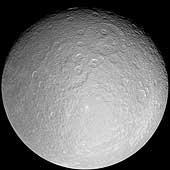|
COMETS EARTH JUPITER KUIPER BELT MARS MERCURY METEORITES NEPTUNE OORT CLOUD PLUTO SATURN SOLAR SYSTEM SPACE SUN URANUS VENUS ORDER PRINTS
PHOTO CATEGORIES SCIENCEVIEWS AMERICAN INDIAN AMPHIBIANS BIRDS BUGS FINE ART FOSSILS THE ISLANDS HISTORICAL PHOTOS MAMMALS OTHER PARKS PLANTS RELIGIOUS REPTILES SCIENCEVIEWS PRINTS
|
Related Document
Download Options
This giant mosaic reveals Saturn's icy moon Rhea in her full, crater-scarred glory. This view consists of 21 clear-filter images and is centered at 0.4 degrees south latitude, 171 degrees west longitude. The giant Tirawa impact basin is seen above and to the right of center. Tirawa, and another basin to its southwest, are both covered in impact craters, indicating they are quite ancient. The bright, approximately 40-kilometer-wide (25-mile) ray crater seen in many Cassini views of Rhea is located on the right side of this mosaic (at 12 degrees south latitude, 111 degrees west longitude). See PIA07764 for a close-up view of the eastern portion of the bright, ray crater. There are few signs of tectonic activity in this view. However, the wispy streaks on Rhea that were seen at lower resolution by NASA's Voyager and Cassini spacecraft, were beyond the western (left) limb from this perspective. In high-resolution Cassini flyby images of Dione, similar features were identified as fractures caused by extensive tectonism. Rhea is Saturn's second-largest moon, at 1,528 kilometers (949 miles) across. The images in this mosaic were taken with the Cassini spacecraft narrow-angle camera during a close flyby on Nov. 26, 2005. The images were acquired as Cassini approached the moon at distances ranging from 79,190 to 58,686 kilometers (49,206 to 36,466 miles) from Rhea and at a Sun-Rhea-spacecraft, or phase, angle of about 19 degrees. Image scale in the mosaic is 354 meters (1,161 feet) per pixel. |

